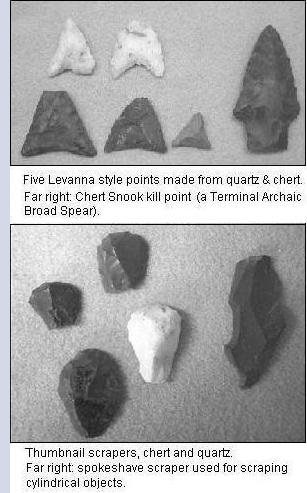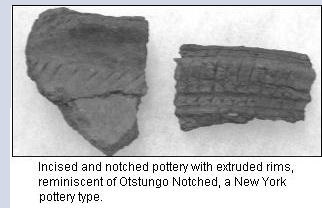Selected Reprints
The Hicock-Benson-Palmer Site: A Significant Late Woodland Living Site in South Britain
by Lucianne Lavin, PhD, Director of Research & CollectionsInstitute for American Indian Studies, 38 Curtis Road, Washington, CT.
Reprinted with permission from "The Birdstone Newsletter," Spring/Summer 2008.
The HBP site (6NH109)1 was excavated in 1973-74 by the Shepaug Valley Archaeological Society under the
direction of Ned Swigart. The site had been discovered during land clearing activities for house construction near
Transylvania Brook. The salvage archaeology was an effort to recover as much information as possible before the site was
destroyed. SVAS members excavated over 100 five-foot squares totaling 2625 square feet. They recovered thousands
of artifacts and many cultural features representing Indian cooking hearths and trash pits with the remains of ancient
meals and other interesting items.
Dr. Swigart went on to found the Institute for American Indian Studies with Sydney Hessel, becoming its first director
and incorporating the SVAS dig finds into our collections. While perusing his notes and other documents, I began to realize
how important the site was to the history of western Connecticut. Except for a small Terminal Archaic Broad Spear component
(1750-750 BC) and an even more ephemeral Middle Woodland component (ca. AD 1-500), the site represents a 14th century Late
Woodland multi-seasonal camp/hamlet. Furthermore, the Late Woodland occupations were concentrated within a thick black,
charcoal-laden living floor and virtually all of the cultural features extended from the black lens into the orange
subsoil. HBP site has the most extensive assemblage of primarily unmixed Late Woodland cultural remains in interior
western Connecticut of which I am aware.

This single component context is important because we can associate the cultural features and other, non-diagnostic
items within it with the Late Woodland people who made and used the ca. 375 diagnostic triangular Levanna arrow points
recovered from the site.2 Those items included knives, choppers and clay cooking pot fragments that indicate
food preparation activities; drills, scrapers, and a possible adz that indicate woodworking; a possible sinew stone
that may suggest the processing of deer tendon, strands of which make a tough fiber for stringing bows, hafting stone
artifacts to wooden or bone or antler handles, or using in any way one would employ string or cordage.3 Stone
cores, hammer stones used to knap them, anvil stones on which the cores were placed for knapping, unfinished tools in
various stages of manufacture, and thousands of stone flakes and shatter (called debitage) demonstrate that tool
manufacture and maintenance was a major activity at the HBP. The near absence of cobble cortex suggests occupants were
quarrying the ledge quartz located on the hillside above the site. The site also contained pieces of red ochre, whose red
iron oxides were mixed with animal fats or plant oils to make pigment for painting items or possibly even as body paint
(17th century Europeans reported that local Indians painted and tattooed their bodies to enhance their beauty, to
acknowledge clan membership, and to impart symbolic meaning during times of war, mourning, and various social festivities).
Dr. Swigart reported nut shell fragments, seeds of polygonum sp4 (which can be ground into meal) and
sumac (used as a tea and a medicinal tonic), a cherry pit, a berry seed, and faunal remains (mainly whitetailed deer but
also elk or moose, bear, turkey, squirrel, hawk/eagle, clam shell and one fish vertebra), which also demonstrate food prep
and consumption. A canine tooth may indicate the presence of dogs onsite.
The large number of artifacts and the variety of human activities they represent, the relatively large number of
hearth features, and the various styles of pottery suggest a multifamily hamlet type of settlement that was repeatedly
occupied over a number of years. Two hearths from the site and one from a nearby rock shelter provided the following
radiocarbon dates: AD 1320 +/- 150 years; AD 1380 +/- 100 years for the open air camp and AD 1410 +/- 110 years from the
Hicock-Hensel Cave.
The floral remains suggest the site was inhabited in the summer and early fall. Wild cherries are available in late
June-July, hickory and butternut/walnut ripen in September-November, sumac berries and seeds from the various species
of polygonum are available in late summer-early fall. The toe bone of a fawn in the assemblage supports this
assumption; since deer give birth April-June the fawn must have been procured during the late summer or autumn.
Only one post mold5 was discovered on site. However, much of the area had been bulldozed prior to
excavation - including adjacent areas and the ridge above the site. It is possible that house structures had been located
in one or more of those areas, or that the occupants slept in a structure built over the rock shelter, which was later
excavated by SVAS members and found to contain artifacts similar to those recovered from the open air site.
During my direction of phase 3 excavations in the northwest portion of the new New Milford High School, we found an
extensive site with several Archaic period occupations whose pole frame houses were located at the base of the
hill forming the western boundary of the school property. The hearths and majority of the artifacts were concentrated
east of the dwellings, suggesting a separation of sleeping quarters from daily economic activities. This may have
been true for the HPB community as well, with the hill to its west protecting the houses and their occupants from the
wind on cold autumn nights.
One of the most fascinating finds is the pottery. Some exhibit charred food remains on their interiors, indicating
their use as cooking pots. But their main allure is the interesting mixture of styles they represent. Rims decorated
with scallop or ark shell impressions or brushing (supposedly with one of those shells) signify coastal connections,
particularly with the Windsor ceramic tradition of south-central Connecticut. Others are decorated with the impressions
of a cord-wrapped stick or paddle edge. This decorative technique was commonly used by contemporary Hudson Valley Indian
communities west and southwest of the site, as well as those living in southwestern Connecticut. Incised and punctuated
pottery is similar to some found on Hudson and Mohawk Valley sites6 Some of the pottery is decorated with a
trailed/combed technique that suggests the Hudson Valley type Black Rock Trailed.

At least one of these pots exhibits zoned decoration typical of incised pottery styles found in the Hudson Valley,
southwestern Connecticut, western Long Island, and northern New Jersey. Some researchers, including myself, believe
that the incised zoned ware signified a population movement of Munsee-speaking peoples from the Mid-Atlantic into those
areas ca. AD 1000-1300. Indeed some linguists believe that the early contact tribal peoples of western Connecticut spoke
a type of eastern Munsee. These connections are reminiscent of those of the Schaghticoke tribal peoples documents by
missionaries at the Moravian mission located at the village of Schaghticoke in present Kent, CT ca. 1742-1770. They
describe frequent visits to kith, kin, and political allies up and down the Housatonic drainage to Stockbridge, Long Island
Sound, into eastern New York and as far away as Bethlehem, Pennsylvania. Moravian records show Schaghticoke occupants
sometimes married outside their group, such as with Pootatuck and Mahican.7
To summarize, Ned Swigart's notes and my cursory perusal of the cultural remains suggest this is a very important
site because it
• Is the first excavated multi-seasonal Late Woodland hamlet from the region.
• Demonstrates community relationships with Indian peoples to the west and southwest in the Hudson Valley,
southwestern Connecticut, and coastal south-central Connecticut. The chert items and pottery styles suggest these relations
likely involved trade, bride exchange, and kin visits/social gatherings.
• Supports previous findings by Dr. Daniel Cassedy and myself8 that stone tools and clay pots from
the middle Housatonic Valley of Connecticut (Newtown/Brookfield area) indicated strong cultural associations with Hudson
Valley Point Peninsula/Owasco cultural groups, while those from the lower Valley (Milford) showed strong affiliations
with the Windsor tradition of south-central Connecticut and Long Island.
• Is seemingly different from contemporary 14th century Late Woodland sites in the Connecticut River Valley as
well, in that there was no evidence for the relatively extensive use of cultigens (maize, beans, sunflower) and
wild plants found at the latter sites. The pottery styles at those sites also appear very different. These cultural and
economic distinctions may be the root of the sociopolitical/tribal distinctions evident in the post-contact period.
Of course, these preliminary findings remain theories until we have studied the site much more intensely, which
we fully intend to do in the near future.
1 This is the site number given by the Office of State Archaeology under the old trinomial system;
6=Connecticut, the sixth state in the union, NH= New Haven County, and 109= it was the 109th reported archaeology
site in that county.
2 A diagnostic artifact is one whose style was produced during a specific time period and/or by a specific
culture. An example is the Levanna projectile point style, which was manufactured by southern New England peoples from
about AD 900 till European settlement, ca. AD 1650-1750.
3 One primitive technologist informed me that he believed the true function of a "sinew stone" was stone
tool manufacture; rubbing the preform in the "sinew" groove strengthened its striking platform and allowed the knapper to
remove flakes to form the tool.
4 The specimen was unidentified as to species. Polygonum is a genus of the buckwheat family; knotweed,
knotgrass and smartweed are examples.
5 A post mold is a dark circle in the ground produced by the rotting of a wooden post. A pattern of post
molds often identifies the location of an Indian dwelling known as a wigwam or weetoo, domed houses of pole frame
constructions.
6 For example, see Robert Funk's 1976 Recent Contributions to Hudson Valley Prehistory (NYS Museum Memoir
20, Albany) and Donald Lenig's 1965 The Oak Hill Horizon and its relation to the Development of Five Nations Iroquois
Culture (NYS Archaeological Association, Buffalo).
7 The Moravian Archives are located in Bethlehem, PA. They are on microfilm and available in many
university libraries, including UCONN, Yale, and WESTCONN.
8 For example, see Cassedy and Lavin's 2007 Prehistoric Interaction between Eastern New York and Southern
New England (Bulletin of the Archaeological Society of CT, volume 69).